|
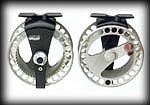
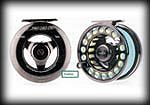
For example: one very respected Russian fisherman
specialized on salmon fishing, on our question:
"Why do you so love to work with L/A spools?"
He has answered us the following: "Imagine...Quite big salmon
species took the hook, and practically instantly "has pulled out"
from the reel the line and all stock of backing. After
that salmon turned in another direction and with the
same speed runs directly to you. And you're starting
to regret that winding ratio of your reel is only 1:1
and you have no time to wind all this back."
In this section also it is necessary to bring attention
on to "Anti-Reverse" reels, as now practically all well-known
companies have in their arsenal one or two such kinds of models.
This kind of reels are very popular at present because of
their convenient and safe principle of work So, when the
line goes screaming off the reel hooked to a bonefish,
tarpon or striper, you can get your knuckles rapped hard
with a handle that's spinning about 16,000 rpkm in
reverse. An anti-reverse eliminates this problem! When
the spool is spinning in the line - out direction,
the handle doesn't move. The handle turns only in
the 'line-in' direction. On D/D (Direct Drive) models
the handle is connected directly to the spool and revolves
with the spool in both directions...
One of our friends, adherents of usual D/D models, is
figurative and not without a little of irony said that
A/R models ideally suit for piano players, programmers
and surgeons. Really, yours fingers will not suffer in
any case, if you use such kind of reel. In our opinion,
these reels, on their basic qualities, just a little
differ than usual (D/D) and desire or unwillingness to
recognize them concerns closely to psychological aspects
of fly angler.
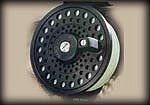
Finishing the story about A/R models we would like to show
you a pair of examples of such models (see fig. 12, 13) on
which are represented A/R models of "Orvis" and "MEGOFF."
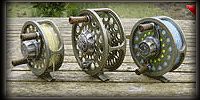
FUNCTION OF BRAKING:
Perhaps, there is no other such functional feature of modern
fly fishing reel, which would cause so polar attitudes to
herself from flyfishers and manufacturers of reels. On
pages of the specialized magazines, on different fly
fishing Internet's chats and forums, you may find a lot
of articles and discussions between fly fishing experts
about, whether the powerful brake for reels of an average
and heavy class is necessary in general. There are a lot
companies which produce similar classes of reels with
brakes or practically by complete absence of brakes. For
example, Orvis "Vortex 7/8" and Abel TR/3 (see fig. 14, 15).
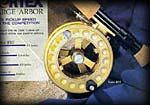
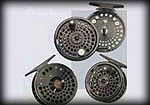
Why one fisher uses reels with rather powerful brakes,
while another, even having the similar reel, use its brake
function in a minimal volume, i.e. only for easy breaking
to avoid entangling of the line when working
with the line? The essence of dispute of such adherents
and opponents of brakes can be tried to transfer in
imagined fishing dialogue of two fishermen specialized on
salmon fishing:
"Why have you got this super fashionable 'Vortex?' Is
there any benefits from these powerful brakes?"
"Well.. yes! I saw yesterday your acrobatic manipulations
with the Abel, when you hooked the big salmon. Are your
fingers safe? You have broken them so, that is still not
clear from whom a smoke, from hands or from the reel's rim
control?"
"But anyway the fish has been caught! And you with your
super powerful brakes, while tried to reach by hands the
drag control knob and slightly reduce the drag moment,
your fish "has broke off" the fly at once."
"And when I caught the huge salmon the day before yesterday?
Quite quietly! You would never stop him, and I has stopped
him only because of my powerful brake, although telling the
truth she acts quite quiet and such kind "of art gymnastics"
as your today's juvenile fish did not show, just pressed by authority
and their weight... And so on..."
If we closely ponder about this dialogue, the first impression
is, that this problem carries only psychological character.
Really, among the fly fishing fans there are a lot of fishers,
which in a half of hour of fly fishing will take in hands
the spinning rod with a spinning reel. Every spinning reel has
the disc drag system of brakes... Means that with brakes on
spinning reels everything is OK, but for fly fishing reels
this issue is still under discussions.
Often, even the skilled fishers can't explain particularly,
why they do not like a reel. Certainly, the roots of this
phenomenon lays, and in the special and ancient traditions
of fly fishing, in psychology of fishermen. Therefore many
of them tried to confine their catch not to brakes, but to
own fingers and feelings.
So, what, in our point of view, is bad with brakes of present
fly fishing reels, and what is good, also what they will be,
or should be?
About reels brakes from 0 up to 4-5 classes, very probably
we could not say much. Their usual purpose is easily
breaking to prevent "entangling" of the
line and backing when working with line. Design differences
of such kinds of brakes are minimal.

Look at the classical models of Orvis "Battenkill"
(see fig. 16) and House of Hardy "Marquis" (see fig. 17)
for example, and you will make to itself complete impression.
The brakes on such reels have so traditional and settled
design, that some of them are still in production and
continue to remain "very popular."
 Recently our English friend and business partner has passed
us his Hardy's "Marquis" from own collection. The reel made
by famous company 20 or 30 years ago, was in a perfect
working condition, and most important, externally
absolutely similar as, featured in their catalogue
for year 2000. The only thing, which irritates some
fishers on such and not only such kind of reels is
importunate, pursuing sound of click. The people
preferring silence and calmness on fishing, this sound
is very (extremely) annoying. And, if on models such
as "spring and pawl," or "Click and Pawl" the presence
of a click is a specific design feature of brake, on
some other models with disk brakes the presence of click
(sound) is not improved by anything (just for sound).
Although, in some situations an outgoing click may
help to better determine the speed of running fish,
it seems for us rather doubtful indemnification for
such information.
Recently our English friend and business partner has passed
us his Hardy's "Marquis" from own collection. The reel made
by famous company 20 or 30 years ago, was in a perfect
working condition, and most important, externally
absolutely similar as, featured in their catalogue
for year 2000. The only thing, which irritates some
fishers on such and not only such kind of reels is
importunate, pursuing sound of click. The people
preferring silence and calmness on fishing, this sound
is very (extremely) annoying. And, if on models such
as "spring and pawl," or "Click and Pawl" the presence
of a click is a specific design feature of brake, on
some other models with disk brakes the presence of click
(sound) is not improved by anything (just for sound).
Although, in some situations an outgoing click may
help to better determine the speed of running fish,
it seems for us rather doubtful indemnification for
such information.
Though, we are absolutely sure that such models have
their own niche on the market today, simply, fishermen
should have a choice to turn it "On" or "Off."
Now, let's get back to a problem with brakes on the reels
of middle and heavy class.
To understand it, let's try to recollect just a little
from school lessons of physics.
So, there are only few physical principles of absorption
and dispersion of energy, on which the brakes of reels
can be designed:
Frictional brakes;
Hydraulic brakes;
Magnetic and electromagnetic brakes.
Frictional brakes or brakes of dry friction
The absorption and dispersion of energy occurs because
of friction of two or more surfaces with each other.
This process is a very well known for a long time and
described by the following Law:
Force of friction = coefficient of friction multiplied
on force of pressing of one surface to another.
From the above follows that to influence on a force of
friction between two surfaces, in our case this is rotated
and motionless disks of the brake, i.e. to make the brakes
more or less powerful, it is possible using only two ways,
either use materials with a big friction coefficient,
or to increase the force of pressing. This is the only
fundamental law the manufacturers use in their research
works...Also, the special attention is given to selection
of a frictioned materials of brake disks made from and,
of course, to their own designs of brake systems.

Unfortunately, in designing of classical disk brake systems
of reels, recently, we may see (in our point of view)
quite not clear and sad tendencies. The quite good and
efficient enough design, on our view, is thoughtlessly
duplicated up to irrationality. The example is an application
of cork in materials of brakes. Yes, this material well
enough works at low compression of pair of friction,
yes does not change much their characteristics if a
little water will get (penetrate) on to braking surfaces...
And many, even a very solid and respected companies, begin
a thoughtless race. Let's open, for example, "Orvis" year
1999 catalogue and we can see the following table (see fig. 18).
(We have overtaken all competitors! The brake disk of our
reel has the largest area in square inches!)
Let's try to find in the above mentioned formula the
size of braking discs surfaces? The same tendency we
can see and with other reels manufacturers. It seems
sometime, that in design of new reel's brakes involved
the same people which love big develop external design/look
of the same models of reels. And all of this finally, "pours
water on a mill" of the opponents of brakes in general.
Such brakes non-uniformly and unstabely work, have quite
high level of "startup" inertia, they change the
characteristics if water gets (penetrating ) between
surfaces of disks, they have quite small braking
adjustments range.
Let's recollect arguments of the fisher, opponents of
brakes at all. "Better by fingers, than such kinds of brake."
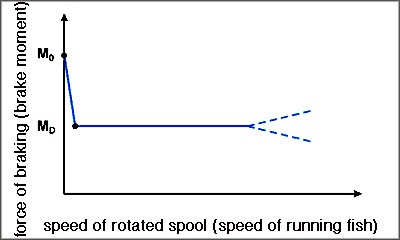
Now some more physics. Let's try to draw the diagram of
changing the force of braking (brake moment) depending
from the speed of rotated spool (speed of running fish)
for disc brakes (fig. 19). By physical feature of a
frictional brake, which is very useful, is that they
are constant and do not depend from speed. Some increasing,
or reduction, comes in area of very high speeds and is
explained by structural changes in a superficial layer
of pair of discs because of high temperatures, which
arose during friction. But this fact should not disturb
us much at the moment. Much more unpleasant feature of
frictional brakes is the existence of "friction of
immovability" and "friction of sliding," to tell more
correctly, the differences between them for the same
(subject to friction) pair of materials. The factors of
"friction of immovability " and "friction of sliding"
for one pair of the materials can sometimes be differ
in tens times. It results, to so-called in magazines
and catalogues "startup inertia" of brakes. In what
it is expressed practically. Look at the diagram.
Let's assume, you adjust the brake after fish is on
your hook. A fish runs away very quickly, you increasing
the braking moment until the point marked (Md)
(See fig. 19), and the fish stops. It would seem,
all is good, the leader, line and backing are OK, the
fish is stopped. But now the braking moment transforms
from the (Md) ("friction of sliding") to the point called
(Mo) ("friction of immovability"). Suddenly, the jerk of the
not-absolutely-got-tired fish follows and brakes which
have not had time to be reconstructed on former point (Md)
further do not "let off the spool," and breakage of
the leader follows. The opponents of brakes are in triumph.
But it seems to us rather early. It appears that there
are pairs of materials, "friction of immovability" of
which differ very little from the factor of "friction
of sliding." It gives some hope to the adherents of
the disc brakes. Some manufacturers of reels, conduct
the scientific researches on selection of such materials
and have already achieved the certain success. Also,
try to look at the brakes of your car! Does anyone see
any cork?
The successful example of application of Teflon as material
for brake disks is known quite well. This material has
extremely low "factor of friction", and the difference
between "friction of immovability" and "friction of sliding"
are very low. We (MEGOFF), for example, in design of brakes
of our reels using the few pairs of rather small in diameter
discs called "stainless steel - carbon fiber composite."
It also has the very good characteristics and some other
advantages, such a wide adjustment range. Braking discs
are fully sealed in the drag block to protect them from
water or sand.
Hydraulic brakes.

The absorption and dispersion of energy occurs for the
account of a liquids leaking through an obstacle
(small hole or few holes...). To the honor of the designers
of reels they have not missed this principle and have
created the STH reel with hydraulic (turbine) brakes
(fig. 20). Unfortunately, we think, this idea does not
have any future, as the physical principle incorporated
in the design of such kind of braking system, contradicts
the basic requirements to brakes of fishing reels. What
means? Following the law of hydraulics, hydraulic brake
has changeable and nonlinear dependence of the braking
moment from speed (in this case rotations of the spool).
On small revolutions of the spool the brake does not
work at all, and than faster fish runs, the braking
moment is higher. But it is an absurdity.
Magnetic and electromagnetic brakes.
Very probably, reels, with brakes designed on such physical
principle have a big future. Really, it is possible to get
brakes with any characteristic on speed or acceleration
of a fish. A brake does not have any mechanically contacted
surfaces. Some attempts already were, for example, in
creation of spinning reels of a very famous company DAM,
in designs of some multipliers of Abu and Shimano. But
until there will be designed the compact and powerful enough
constant magnets and sources of energy, to speak about
application of this physical principle in brakes of fly
fishing reels seems too early.
There are some more features of brake systems of modern
fly fishing reels, which it is necessary to mention.
If on light models of reels the braking moment is small
and does not create any inconvenience when reeling in,
but on reels of middle and heavy class this may be quite
inconvenient. Therefore designers develop for such reels
special systems which disconnect the brake when reeling
in. Mainly they design a kind of "One way toothed clutch,"
which connect or disconnect the motionless braking disk
with the reels frame, depending on a direction of spool
rotation. Mainly, all reels manufacturers used the same
principle with a minor constructive changes. Some reels,
including ours, are equipped with a fully sealed "one
way clutch" or "one way bearing" system which in our
point of view is much more reliable and long lasting.
There is one more important issue, which should be solved
and some of manufacturers are working on it. As we
explained before, the brake of fly fishing reel should
correspond two functions. "Put on the brakes," a little
when working with a line and to create a quite big braking
moment when playing a fish. Mainly on all modern fly reels
we may see this contradiction and fight with it we may
only by regulation of brake knob depending from fishing
situation.
But not always we have enough time for it, and because of
that some fly anglers prefers to set up the braking moment
of their reels only to work with a line. And we suppose
that soon some of manufacturers will release the reel on
which we could with only one movement of hand to set the
brake from the smallest braking moment to another beforehand
regulated point.
That's all probably... But we would not suggest you to
be under delusion that if we know all the problems that
early or lately we will see the fly reel with all
mentioned features. That not right.
If we solve this main problems we will be definitely
facing to another problems, such as: complication of
reels design and therefore reliability deterioration
and of course weight increasing.
Most likely, from the brakes point, reels will be designed
of two versions: simple and light with some kind of
"click & pawl" system and more complicated and heavier
with disc drags.
FUNCTION of BALANCING.
As fly fishing is a quite mobile kind of sport and angler
should make plenty of manipulations with their rod, reel
and line, so, therefore there is a question about how
easily and conveniently to do it. In our case the speech
goes about the reel, as some kind of "concentrated
weight/mass," which with their weight and arrangement
on the rod influence on the balancing of system
"reel - rod - line." The inattentive attitude
to this question will result not only to the raised
fatigue while fishing, but also, and this is even more
important, that you can not realize correct and normal
cast. What is necessary to know and to do to prevent this?
Regarding to the reel it seems impossible to decide
unequivocally is should be it lighter, or heavier?
It is possible, if you already have the rod and the
line and just seeking the proper reel size. In other
words, the system should be balanced the way the
center of gravity of the entire system ( Rod - Reel - Line)
should be in the point, in which you hold it when casting,
i.e. in the handle of your rod. This will allow to lower
loading on the stroke of your hand and to achieve exacter
casting performance.
Now about some concrete situations. So, it seems, that
for "ultra light" and "light" fly fishing tackle, i.e.
up to 4-5 classes, balancing of system unequivocally
requires enough light reels. It is because of big
technological progress, which was achieved by rods
manufacturers. Modern fly fishing rods of a small
class made from hi-moduled carbon composite, kevlar
and boronfiber, are only 60 - 70 gram in weight.
Therefore, it requires and small weight of reels
for good balancing of the "system." Because of that,
many firms make such kinds of reels of extremely simple
design and therefore they are very light.

 Examples: Orvis "Traditional CFO 123 (fig. 21), which
weighs only 91 grams, or even lighter Loop "Featherweight
Midge" (fig. 22). But for the reels of middle and especially
of heavy class not so unequivocal.
Examples: Orvis "Traditional CFO 123 (fig. 21), which
weighs only 91 grams, or even lighter Loop "Featherweight
Midge" (fig. 22). But for the reels of middle and especially
of heavy class not so unequivocal.
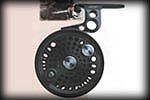
In modern fly fishing there are two in parallel developing
directions. Let's call them: "American" and "European."
The first one differs by using of average and heavy classes
of ordinary (single-handled), rigid and quite short rods.
The "European" direction assumes using double-handled,
soft and quite long rods. Naturally, requirements to
the balancing, and consequently, to the reels weight,
for double-handled rods are not so important.
 Taking into account, that the progress in creation of extremely
light rods has touched and rods of middle and heavy class,
including double-handled, the problem of creation of
light reels for this kind of rods should become in
the near future. However, it is possible to solve
this problem not only by reduction of weight of the
reel. Some firms, such Abel (fig. 23), or Henchel (fig. 24),
made their standard models with some special reel feet,
which allow to change the positioning of the reel on rods
handle, i.e. to balance "system" by changing center of
gravity of entire "system."
Taking into account, that the progress in creation of extremely
light rods has touched and rods of middle and heavy class,
including double-handled, the problem of creation of
light reels for this kind of rods should become in
the near future. However, it is possible to solve
this problem not only by reduction of weight of the
reel. Some firms, such Abel (fig. 23), or Henchel (fig. 24),
made their standard models with some special reel feet,
which allow to change the positioning of the reel on rods
handle, i.e. to balance "system" by changing center of
gravity of entire "system."
|

 Although these reels are quite expensive, look at the
following characteristics: Titanium as
material is more than twice stronger then all existing
aluminum alloys. It does not need any protective coatings.
The material may work well up to 500 C. 100% corrosion
protected in fresh and salt water, in organic and non-organic
acids and Alkalitieses (Sulfuric acid, Nitric acid etc.).
We predict the BIG future for such kinds of reels, especially
if their price gets down.
Although these reels are quite expensive, look at the
following characteristics: Titanium as
material is more than twice stronger then all existing
aluminum alloys. It does not need any protective coatings.
The material may work well up to 500 C. 100% corrosion
protected in fresh and salt water, in organic and non-organic
acids and Alkalitieses (Sulfuric acid, Nitric acid etc.).
We predict the BIG future for such kinds of reels, especially
if their price gets down.
 The quality of anticorrosive and
anti-frictional coatings of many of the well-known firms,
such as Orvis (see fig. 2), Tibor and Henschel (see fig. 3)
is such that the reliability of the reels is extremely high.
The quality of anticorrosive and
anti-frictional coatings of many of the well-known firms,
such as Orvis (see fig. 2), Tibor and Henschel (see fig. 3)
is such that the reliability of the reels is extremely high.
 Many firms are spending lots of R&D dollars in this area
and we believe that soon we will see hi-tech ceramic coatings
will replacing traditional anodizing. There is however
the possibility that some of the currently available
coatings will detract from the overall aesthetics of
the reel thereby conflicting with one of our essential
functions, that of the 'fashionable toy!'
Many firms are spending lots of R&D dollars in this area
and we believe that soon we will see hi-tech ceramic coatings
will replacing traditional anodizing. There is however
the possibility that some of the currently available
coatings will detract from the overall aesthetics of
the reel thereby conflicting with one of our essential
functions, that of the 'fashionable toy!'

 This is effectively a multiplying reel, that is the number
of turns of the spool is more than the number of turns of
the handle. There are fly reels, called "automatic";
automatic spool's rotating provided using steel spring's
energy (this principle realized mainly on all mechanical
watches). Now such kind of reels are not very popular and
from modern reels it is probably the only model: "Mitchell
710 Automatic (see fig. 6).
This is effectively a multiplying reel, that is the number
of turns of the spool is more than the number of turns of
the handle. There are fly reels, called "automatic";
automatic spool's rotating provided using steel spring's
energy (this principle realized mainly on all mechanical
watches). Now such kind of reels are not very popular and
from modern reels it is probably the only model: "Mitchell
710 Automatic (see fig. 6).









 Recently our English friend and business partner has passed
us his Hardy's "Marquis" from own collection. The reel made
by famous company 20 or 30 years ago, was in a perfect
working condition, and most important, externally
absolutely similar as, featured in their catalogue
for year 2000. The only thing, which irritates some
fishers on such and not only such kind of reels is
importunate, pursuing sound of click. The people
preferring silence and calmness on fishing, this sound
is very (extremely) annoying. And, if on models such
as "spring and pawl," or "Click and Pawl" the presence
of a click is a specific design feature of brake, on
some other models with disk brakes the presence of click
(sound) is not improved by anything (just for sound).
Although, in some situations an outgoing click may
help to better determine the speed of running fish,
it seems for us rather doubtful indemnification for
such information.
Recently our English friend and business partner has passed
us his Hardy's "Marquis" from own collection. The reel made
by famous company 20 or 30 years ago, was in a perfect
working condition, and most important, externally
absolutely similar as, featured in their catalogue
for year 2000. The only thing, which irritates some
fishers on such and not only such kind of reels is
importunate, pursuing sound of click. The people
preferring silence and calmness on fishing, this sound
is very (extremely) annoying. And, if on models such
as "spring and pawl," or "Click and Pawl" the presence
of a click is a specific design feature of brake, on
some other models with disk brakes the presence of click
(sound) is not improved by anything (just for sound).
Although, in some situations an outgoing click may
help to better determine the speed of running fish,
it seems for us rather doubtful indemnification for
such information.



 Examples: Orvis "Traditional CFO 123 (fig. 21), which
weighs only 91 grams, or even lighter Loop "Featherweight
Midge" (fig. 22). But for the reels of middle and especially
of heavy class not so unequivocal.
Examples: Orvis "Traditional CFO 123 (fig. 21), which
weighs only 91 grams, or even lighter Loop "Featherweight
Midge" (fig. 22). But for the reels of middle and especially
of heavy class not so unequivocal.
 Taking into account, that the progress in creation of extremely
light rods has touched and rods of middle and heavy class,
including double-handled, the problem of creation of
light reels for this kind of rods should become in
the near future. However, it is possible to solve
this problem not only by reduction of weight of the
reel. Some firms, such Abel (fig. 23), or Henchel (fig. 24),
made their standard models with some special reel feet,
which allow to change the positioning of the reel on rods
handle, i.e. to balance "system" by changing center of
gravity of entire "system."
Taking into account, that the progress in creation of extremely
light rods has touched and rods of middle and heavy class,
including double-handled, the problem of creation of
light reels for this kind of rods should become in
the near future. However, it is possible to solve
this problem not only by reduction of weight of the
reel. Some firms, such Abel (fig. 23), or Henchel (fig. 24),
made their standard models with some special reel feet,
which allow to change the positioning of the reel on rods
handle, i.e. to balance "system" by changing center of
gravity of entire "system."

 Figuratively it can be something like this: "I want to have
a car, which externally looks as "Rolls - Royce" of release
30 years ago, but the internally should be super modern... "
Examples: Peerless (fig. 25) or Bellinger - Saracione (fig. 26)
We too have experience of manufacturing of such models. (fig.27)
Figuratively it can be something like this: "I want to have
a car, which externally looks as "Rolls - Royce" of release
30 years ago, but the internally should be super modern... "
Examples: Peerless (fig. 25) or Bellinger - Saracione (fig. 26)
We too have experience of manufacturing of such models. (fig.27)
 Alexander and Vladimir are familiar with modern technologies in the aerospace
industry, and they apply these in the making of their products.
Kharkov remains a vast aircraft-building region so access to high
grade materials and the latest technologies is relatively easy.
Alexander has been a fisherman for more then 30 years, and fly
fishing for more then 15 years, much of that time making his
own fishing tackle and tying his own flies. Up until 1996 we
made fishing gear just for ourselves or for friends and
acquaintances. By early 1997 our reputation had grown and to
satisfy demand we started to make small amounts of fly reels,
flies and fly tying gear to order. Megoff is actively
researching magnetic drag systems, Titanium and large arbor reels.
You can visit their website at:
Alexander and Vladimir are familiar with modern technologies in the aerospace
industry, and they apply these in the making of their products.
Kharkov remains a vast aircraft-building region so access to high
grade materials and the latest technologies is relatively easy.
Alexander has been a fisherman for more then 30 years, and fly
fishing for more then 15 years, much of that time making his
own fishing tackle and tying his own flies. Up until 1996 we
made fishing gear just for ourselves or for friends and
acquaintances. By early 1997 our reputation had grown and to
satisfy demand we started to make small amounts of fly reels,
flies and fly tying gear to order. Megoff is actively
researching magnetic drag systems, Titanium and large arbor reels.
You can visit their website at: